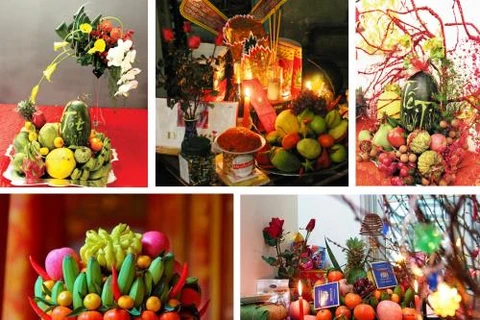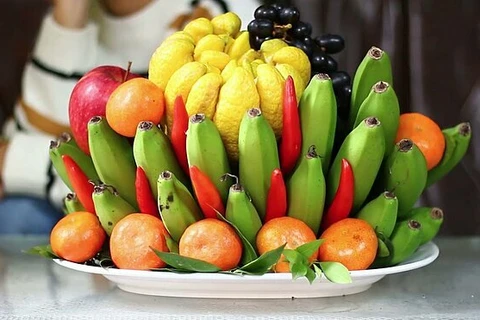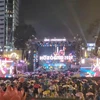 A five fruit tray in the northern region is usually composed of a hand of green bananas, a ripe pomelo (or a Buddha's hand, a shaddock), oranges, persimmons, sapodilla plums, a bunch of kumquat (Photo: VNA)
A five fruit tray in the northern region is usually composed of a hand of green bananas, a ripe pomelo (or a Buddha's hand, a shaddock), oranges, persimmons, sapodilla plums, a bunch of kumquat (Photo: VNA) Hanoi (VNA) - Among the numerous offerings that are required to decorate ancestral altars during the traditional New Year, a five-fruit tray is indispensable for each Vietnamese family. It is a symbol of the wholeheartedness and filial piety of the present generation towards their ancestors and the gednie of the land.
No matter whether rich or poor, on New Year’s Eve, it is important for the Vietnamese people to select the best five-fruit tray to offer to their ancestors and deities. The fruits are often placed on a red-lacquered wooden tray and arranged in a balanced cone and in harmonious colours
Like other popular rituals, the preparation of a five-fruit tray for Tet has become an established convention. During the days just before Tet, the Vietnamese people begin to buy the necessary fruits for this purpose.
Fruits to offer to ancestors can differ in different parts of Vietnam, depending on their respective weather conditions at the time and on available local agricultural products. However, the common thing is each tray must have five fruits as people consider it a lucky sign.
A five-fruit tray in the Northern region usually comprises a handful of green bananas, a ripe pomelo (or a Buddha's hand, a shaddock), oranges and persimmons, sapodilla plums, a bunch of kumquat, and in recent years, one can add mangoes and grapes from southern Viet Nam, or apples and pears from China.
Although it is called a five-fruit tray, it does not necessarily contain exactly five kinds of fruit.
Arranging fruits on the crimson, hour-glass shaped wooden tray is really an art. One has to combine the colours and shapes of different fruits while arranging them on the tray to make it look like a still-life picture.
To ensure balance on the tray, the bananas are usually put upright in the middle, and the pomelo on the concave surface of the bananas. Then the oranges, sapodilla plums and apples are put in the gaps between the bananas and the pomelo. The last small gaps are filled with little kumquats to create a full, compact tray of fruits.
The tray presents a harmonious combination of the different colours of fruits: the dark green of banana, the light yellow of pomelo, the deep red of persimmon and reddish-yellow of oranges and kumquats, as well as the light green of apples, and the dark brown of sapodilla plums.
Southerners prefer sugar-apples, coconuts, papayas, mangos and fig fruits for this five-fruit tray as they sound like “wishing for enough fortune” in Vietnamese language.
To complete the picture, the fruit tray is sprinkled with some small, fresh kumquat leaves.
The five-fruit tray, together with horizontal lacquered boards engraved with Chinese characters, parallel sentences written on red paper, and ornamental kumquat and peach trees, besides popular Hang Trong and Dong Ho pictures, transcends its material value to become a spiritual symbol and an original national product in the spiritual life of the Vietnamese people.
At present, while many ancient spiritual values have disappeared, the custom of arranging the five fruit tray on the altar during the lunar New Year days is being preserved as a fine legacy of Viet Nam's traditional culture.
The “Mam Ngu Qua” in Tet Festival represent the quintessence that Heaven and Earth bless humans. This is one of the general perceptions of life of the Vietnamese, which is “An qua nho ke trong cay” (When taking fruit, you should think of the grower)./.






















